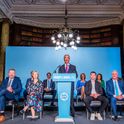Some time in the next two weeks, Geoffrey Cox, the splendidly Rumpolean Attorney General, is expected to return from Brussels, flourishing a piece of paper. The Northern Ireland “backstop” is amended, he will announce. We can get out of it. Here is my new legal advice. And this modified version of Theresa May’s Brexit deal will pass in parliament, perhaps after a short extension of Article 50 for ratification purposes.
But suppose this comfortable outcome does not happen? What happens if Cox fails? Will Britain have to request a humiliating lengthy extension of the Article 50 process, perhaps with a view to reversing Brexit altogether?
Not necessarily. Another choice which remains on the table, is the so-called Norway option, or falling back on the UK’s existing membership of the European Economic Area (EEA). Critically, this is a separate treaty to the EU treaties to which we are signatories in our own right. And it remains on the statute book via the European Economic Area Act, 1993, which has not been repealed. The Norway option has several advantages which ought to make it a compelling proximate objective to deliver the referendum result, while avoiding the many other risky and chaotic options such as a no-deal.
The EEA was conceived by former Commission president Jacques Delors to “promote a continuing and balanced strengthening of trade and economic relations” by widening access to the single market beyond EU members. It is quite similar to the transition period envisaged in the Withdrawal Agreement, but with greater sovereign rights and protections.
The government’s legal position on the EEA has evolved. Initially, it claimed we were leaving the treaty automatically as a consequence of leaving the EU. But following challenges in the courts (including a Judicial Review in 2017) and by Lord Owen (the former Labour foreign secretary), it now claims the treaty will “no longer be operative” and that it intends to incorporate an exit in the EU Withdrawal Agreement Bill. That provision may not pass.
The EEA treaty has two governance pillars. We are leaving the EU one, adjudicated by the European Court of Justice, and this does indeed make the treaty inoperative. But we can make the treaty operative again by applying to join the other, European Free Trade Association (EFTA) pillar. On top of that pillar sits the EFTA court and co-existing happily inside it are Norway, Iceland and Lichtenstein.
Under international law the presumption is that our application to EFTA would have to be accepted. The relevant legal maxim is Ut res magis valeat quam pereat (the thing should be made to work rather than fail). If the EU did object to us asserting our rights under the EEA, we could go to international arbitration.
The EEA is a working free trade agreement. We would be outside the customs union, the common fisheries policy, the common agricultural policy and the jurisdiction of the ECJ. The EFTA Court (on which the UK would have two out of five judges) and the ECJ do work together to create a homogenous area of law, but are not obliged to follow each other.
We could make our own trade deals. There is no common citizenship, so British passports would be back. And when it comes to law-making we would have rights of decision shaping, adaptation and veto. Furthermore, if we did not like it the EEA has a very permissive exit process under Article 127: just 12 months’ notice in writing. As we would be members of the single market it would create the legal basis, and the trust, to do away with or at least minimise the dreaded backstop.
What is not to like? Three words. Freedom of movement. Under the EEA we would have to sign up in principle to freedom of movement. The treaty does allow for both an emergency break and administrative measures to limit free movement and Lichtenstein has even put in a cap. But it is obvious that the reason Theresa May originally discarded the EEA option is that she has always seen the referendum result as a vote against immigration, as opposed to wider sovereignty issues.
There is already a cross-party movement led by the Conservatives Nick Boles and Oliver Letwin and the Labour MP Stephen Kinnock for something called “Norway plus.” This differs from the straight Norway option because it is premised on voting for the Withdrawal Agreement in full, including the backstop, and only adapting the political declaration later. They have also proposed a customs union, which would surrender any hope of an independent trade policy.
Brexiteers do not like Norway plus. Its advocates do deserve credit for putting the attractiveness of the EEA on the agenda. But they have been mistaken in not answering the essay question: how to get out of the EU and take back as much control as possible.
Nor have they been sufficiently realistic about the treaty’s shortcomings. The EEA may indeed prove to be an uncomfortable, half-in-half-out position for the UK as some fear. For example, having our financial services subject to Brussels diktats would be unsatisfactory, unless that process can be amended. This is certainly a concern of Mark Carney, Governor of the Bank of England. So we should prepare to move on, if necessary, into the Canada-style free trade agreement favoured by many Brexiteers.
Still, one cannot help thinking that restoring us to the pre-Maastricht Treaty position of a commercial treaty between sovereign nations, with some controls over freedom of movement, is just the sort of holding position with which Britain would be happiest. The inability of the government to recognise this ready solution and instead to try and concoct a bespoke version, fixated on ending free movement, has been one of the greatest ever failures of British statecraft.
George Trefgarne is author of “Norway then Canada, a new strategy to avoid a Brexit smash,” and is founder of the Boscobel & Partners consultancy













